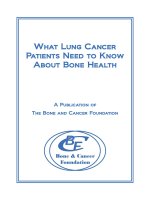Kerzner s what functional managers need to know about project management
Bạn đang xem bản rút gọn của tài liệu. Xem và tải ngay bản đầy đủ của tài liệu tại đây (2.87 MB, 259 trang )
What Functional
Managers Need
to Know about
PROJECT
MANAGEMENT
Harold Kerzner, Ph.D.
Frank Saladis, PMP
John Wiley & Sons, Inc.
This book is printed on acid-free paper.
Copyright © 2009 by International Institute for Learning, Inc., New York, New York. All rights reserved.
Published by John Wiley & Sons, Inc., Hoboken, New Jersey
Published simultaneously in Canada
No part of this publication may be reproduced, stored in a retrieval system, or transmitted in any
form or by any means, electronic, mechanical, photocopying, recording, scanning, or otherwise,
except as permitted under Section 107 or 108 of the 1976 United States Copyright Act, without
either the prior written permission of the Publisher, or authorization through payment of the
appropriate per-copy fee to the Copyright Clearance Center, 222 Rosewood Drive, Danvers, MA
01923, (978) 750-8400, fax (978) 646-8600, or on the web at www.copyright.com. Requests to
the Publisher for permission should be addressed to the Permissions Department, John Wiley &
Sons, Inc., 111 River Street, Hoboken, NJ 07030, (201) 748-6011, fax (201) 748-6008, or online
at www.wiley.com/go/permissions.
Limit of Liability/Disclaimer of Warranty: While the publisher and the author have used their best
efforts in preparing this book, they make no representations or warranties with respect to the accuracy
or completeness of the contents of this book and specifically disclaim any implied warranties of
merchantability or fitness for a particular purpose. No warranty may be created or extended by
sales representatives or written sales materials. The advice and strategies contained herein may not
be suitable for your situation. You should consult with a professional where appropriate. Neither
the publisher nor the author shall be liable for any loss of profit or any other commercial damages,
including but not limited to special, incidental, consequential, or other damages.
Photo credits—2.2, 2.3, 2.8, 2.9, 4.2, 4.7, 4.8, 4.11, 4.13, 4.18, 4.19, 4.20, 6.7, 6.8: PhotoDisc/
Getty Images; 2.4, 2.5, 2.7, 4.5, 4.10, 4.12, 4.16, 4.17, 6.4: Digital Vision; 2.1, 2.6, 3.1, 6.6: Purestock;
2.10, 4.9, 6.3: Artville/Getty Images; 2.11, 4.14: Corbis Digital Stock; 2.12, 6.5: Imagestate
For general information about our other products and services, please contact our Customer Care
Department within the United States at (800) 762-2974, outside the United States at (317) 572-3993
or fax (317) 572-4002.
Wiley also publishes its books in a variety of electronic formats. Some content that appears in
print may not be available in electronic books. For more information about Wiley products, visit
our web site at www.wiley.com.
“PMI”, the PMI logo, “OPM3”, “PMP”, “PMBOK” are registered marks of Project Management
Institute, Inc. For a comprehensive list of PMI marks, contact the PMI Legal Department.
Library of Congress Cataloging-in-Publication Data:
Kerzner, Harold.
What functional managers need to know about project management / Harold Kerzner,
Frank Saladis.
p. cm.—( The IIL / Wiley series in project management)
Includes index.
ISBN 978-0-470-52547-0 (cloth)
1. Project management. I. Saladis, Frank P. II. Title.
HD69.P75K4973 2009
658.4'04--dc22
2009018591
Printed in the United States of America
10 9 8 7 6 5 4 3 2 1
CO NTENTS
Preface vii
Acknowledgments xi
International Institute for Learning, Inc. (IIL) xii
Chapter 1:
PROJECT MANAGEMENT PRINCIPLES
Project Management Humor 2
Project Management 4
Project Necessities 6
Results of Good Planning 8
Project Characteristics 10
The Triple Constraint 12
Resources 14
Types of Project Resources 16
Project Organization 18
Multiple Boss Reporting 20
Project-Driven versus Non-Project-Driven Firms
Complexities in Non-Project-Driven Firms 24
Levels of Reporting 26
Low-Level Reporting 28
Why Use Project Management? 30
When to Use Project Management 32
Relationship 34
The Need for Restructuring 36
Improvement Opportunities 38
Resistance to Change 40
iii
1
22
iv
CONTENTS
Chapter 2:
THE BENEFITS OF PROJECT MANAGEMENT
43
Benefits of Project Management 44
Chapter 3:
SOME IMPLEMENTATION COMPLEXITIES
69
The Challenges Facing Project Managers
70
Working with the Technical Prima Donna
72
Early Reasons for Failure
74
Chapter 4:
ROLE OF THE MAJOR PLAYERS IN PROJECT
MANAGEMENT: THE PROJECT MANAGER
The Three-Legged Stool
77
78
The Project Manager’s Stool
Negotiating for Resources
80
82
The Project Kickoff Meeting
84
Organizing the Project Team
86
Responsibility Assignment Matrix
88
Establishing the Project’s Policies and Procedures
Laying Out the Project Workflow and Plan
Establishing Performance Targets
Obtaining Funding
96
Executing the Plan
98
Acting as the Conductor
Putting Out Fires
90
92
94
100
102
Counseling and Facilitation
104
Encouraging the Team to Focus on Deadlines
106
Monitoring Progress by “Pounding the Pavement”
Evaluating Performance
110
Developing Contingency Plans
112
108
CONTENTS
Briefing the Project Sponsor
v
114
Reviewing Status with the Team 116
Briefing the Customer
118
Closing Out the Project
120
Project Management Skills
122
Chapter 5:
ROLE OF THE MAJOR PLAYERS IN PROJECT
MANAGEMENT: THE PROJECT SPONSOR
The Need for a Sponsor
127
128
The Project Sponsor Interface
130
Chapter 6:
ROLE OF THE MAJOR PLAYERS IN PROJECT
MANAGEMENT: THE FUNCTIONAL MANAGER
Classical Management
134
The Functional Manager’s Role
Staffing Questions
136
138
Worker Understanding and Skills
Special Requirements
Recruitment Policy
133
140
142
144
Degree of Permissiveness
146
The Project Manager’s Recruitment Concerns
Management Plan Data
150
Staffing Pattern versus Time
152
Special Issues with Assignments
154
Conflicting Policies and Procedures
Asking for a Reference
156
158
A Summary of Other Special Issues
The Functional Manager’s Problems
160
162
The Functional Manager as a Forecaster
182
148
vi
CONTENTS
The Type of Matrix Structure
184
The Functional Manager’s View
186
Working with the Project Managers
188
Expectations of the Assigned Resources
Handling Organization Priorities
192
Handling Project-Related Priorities
Balancing Workloads
194
196
Multiproject Planning
198
Changing Resources during the Project
The Impact of Scope Changes
Risk Management
190
200
202
204
Project Documentation
206
Conflicts 208
Conflict Resolution 210
Talking to Project Managers
Project Performance Reports
Estimating and Scheduling
212
214
216
An Effective Working Relationship
Successful Culture
Promises Made
218
220
222
Non-Financial Awards/Recognition
224
Wall-Mounted Plaques for All to See (Cafeteria Wall)
Public Recognition
228
Other Non-Monetary Awards
Public Pat on the Back
230
232
Securing Proprietary Knowledge
Wearing Multiple Hats
Conclusion
Index
241
238
236
234
226
PREFACE
W
hen project management first began, the only industries
that readily embraced project management as a way of doing
business were aerospace, defense, and heavy construction. These
industries were identified as project-driven industries, where each
project had a profit target. The prime objective of project management
was to generate profits, and the project managers had the responsibility
for profit and loss. The survival of the company rested in the hands
of the project managers.
Project managers were viewed as managing profit centers, and
functional manager groups were looked upon as cost centers. The
role of the functional manager was basically to assign resources to
projects and to keep their costs as low as possible. If the project was
successful, then the project manager could expect to receive a bonus.
If the project failed, blame was placed on both the project manager
and the functional managers. Functional managers were treated with
indifference and often received neither bonuses nor credit for doing
their job well.
Functional managers were not required to understand project
management. Their role was to assign resources to projects and often
relied on the project managers to provide daily direction to the
resources. The reason for this was that project managers at that time
were, in almost all cases, engineers with advanced degrees and they
possessed a strong knowledge and command of technology, often a
greater technical knowledge than the functional managers. Functional
managers would basically relinquish any control over the resources
once the resources were assigned to the projects.
As project management matured and the projects became more
sophisticated, it became extremely difficult for project managers to
maintain their technical expertise and continue to possess a command
vii
viii
P R E FA C E
of technology. Many were no longer considered to be technical experts.
Most project managers today have an understanding of technology rather than a command of technology. The technical expertise
resides in the functional areas. As a result, the accountability for the
success of the project is now viewed by many executives and project
sponsors as shared accountability between the project manager and
all participating line or functional managers. With shared accountability, the line managers must now develop a good understanding
of project management, which is why more line managers are now
seeking project management certifications and credentials such as
the Project Management Institute’s PMP® (Project Management
Professional) and CAPM® (Certified Associate Project Manager).
Today, project managers are expected to focus on and manage project deliverables rather than people. Management of the assigned
resources has become a line function.
Today, the technical knowledge repository of most companies
resides in the functional areas. When resources are assigned to a
project, the resources continue to receive technical direction from
their functional managers. Functional managers are now an integral
part of project management and share in the success and failure of
each project. Project management is now viewed as a discipline of team
leadership and team accountability.
As project management continues to evolve and mature, the relationship between the project manager and functional managers continues to mature and is getting stronger. They must work together,
understand each other’s priorities and problems, and resolve issues
jointly. When a functional manager encounters a problem when
assigning resources, the functional manager goes directly to the
project manager for assistance and contingency planning. When a project manager has a resource-related or technical problem, they go to
the functional managers for assistance with the identification of alternatives. Senior management may be called upon to assist in problem
resolution only as a last resort if the project and functional managers
P R E FA C E
ix
cannot reach an agreement. The success of project management
may very well rest upon how well the project manager and functional
managers work together.
The role of the functional manager has changed significantly.
Functional managers now have the power and influence to drive
any project to success or failure by the way they provide support
for the project. Therefore, a positive relationship between project
manager and functional manager is essential. This need for a strong
project manager/functional manager relationship has become apparent in the implementation of the majority of today’s projects, and
senior management has finally realized the importance of functional
management in making project management succeed.
Harold Kerzner
Frank Saladis
International Institute for Learning, Inc. 2009
ACKNOWLEDGMENTS
Some of the material in this book has been either extracted or
adapted from Harold Kerzner’s Project Management: A Systems
Approach to Planning, Scheduling, and Controlling, 10th edition;
Advanced Project Management: Best Practices on Implementation, 2nd
edition; Strategic Planning for Project Management Using a Project
Management Maturity Model; Project Management Best Practices:
Achieving Global Excellence, 1st edition (all published by John Wiley
& Sons, Inc.).
Reproduced by permission of Harold Kerzner and John Wiley &
Sons, Inc.
We would like to sincerely thank the dedicated people assigned to
this project, especially the International Institute for Learning, Inc.
(IIL) staff and John Wiley & Sons, Inc. staff for their patience,
professionalism, and guidance during the development of this book.
We would also like to thank E. LaVerne Johnson, Founder, President
& CEO, IIL, for her vision and continued support of the project
management profession, Judith W. Umlas, Senior Vice President,
Learning Innovations, IIL, and John Kenneth White, MA, PMP, Senior
Consultant, IIL for their diligence and valuable insight.
In addition, we would like to acknowledge the many project
managers whose ideas, thoughts, and observations inspired us to initiate
this project.
—Harold Kerzner, Ph.D., and Frank Saladis, PMP
xi
I NTERNATI O N AL
I NSTITUTE FO R
LE ARN I N G, I N C . ( I I L )
International Institute for Learning, Inc. (IIL) specializes in professional
training and comprehensive consulting services that improve the
effectiveness and productivity of individuals and organizations.
As a recognized global leader, IIL offers comprehensive learning
solutions in hard and soft skills for individuals, as well as training
in enterprise-wide Project, Program, and Portfolio Management;
PRINCE2®,* Lean Six Sigma; Microsoft® Office Project and Project
Server,** and Business Analysis.
After you have completed What Functional Managers Need
to Know about Project Management, IIL invites you to explore our
supplementary course offerings. Through an interactive, instructor-led
environment, these virtual courses will provide you with even more
tools and skills for delivering the value that your customers and
stakeholders have come to expect.
For more information, visit or call +1-212-758-0177.
*PRINCE2® is a trademark of the Office of Government Commerce in the United Kingdom
and other countries.
**Microsoft Office Project and Microsoft Office Project Server are registered trademarks of the Microsoft Corporation.
xii
Chapter
1
PROJECT
MANAGEMENT
PRINCIPLES
2
PROJECT MANAGEMENT PRINCIPLES
PROJECT MANAGEMENT HUMOR
Project management is the art of creating the illusion that
any outcome is the result of a series of predetermined,
deliberate acts when, in fact, it was dumb luck!
PROJECT MANAGEMENT HUMOR
S
3
ome people are under the impression that project success is
accomplished by chance and luck. Nothing could be further
from the truth. Most people will agree that project success is accomplished through a structured process of project initiation, planning,
execution, monitoring and control, and finally closure.
Some companies rely heavily on an organized and consistent project management methodology to accomplish their goals. Some methodologies are based on policies and procedures, whereas others are
developed around forms, guidelines, templates, and checklists.
Project management is an attempt to get nonroutine work to flow
multidirectionally through the company, usually horizontally, rather
than in a vertical, sometimes bureaucratic manner. To accomplish
this multidirectional work flow, a project management methodology
is required. One of the purposes of this structured methodology is
to facilitate the job of integrating the work across various functional
units to meet project objectives.
When projects reach completion or closure, the project team is
debriefed in order to capture lesson learned and best practices that may
be beneficial to the organization and for use on future projects. In most
cases, the best practices that are discovered are used to improve how
the project and functional managers interface and to increase efficiency
in the use of organizational resources.
4
PROJECT MANAGEMENT PRINCIPLES
PROJECT MANAGEMENT
PROJECT PLANNING
Definition of work requirements
Definition of quantity and quality of work
Definition of resources needed
PROJECT MONITORING AND CONTROL
Tracking progress
Comparing actual outcome to predicted outcome
Analyzing impact
Making adjustments
PROJECT MANAGEMENT
5
T
he Guide to the Project Management Body of Knowledge (PMBOK®
Guide) identifies five domain areas in which the project managers
must perform:
Initiation—Defines and authorizes the project
Planning—Defines and refines project objectives
Execution—Integration of resources to meet objectives
Monitoring and Control—Measuring progress and identifying
variances
Closure—Acceptance of project deliverables
The amount of time and effort that project managers must put
forth can vary based on the domain area. Many project managers are
not brought on board the project until the end of the initiation process. Executive management, marketing, and sales may take the lead
during project initiation.
Project managers and functional managers are heavily involved
in project work during planning, monitoring and control. During
project execution, much of the work is accomplished by the project
team and the functional managers. If the project team members
report directly to their specific functional departments, the project
manager’s main contact with these resources may be during monitoring and control of project activities as tasks are executed.
During project closure, the project manager is expected to make
sure that all project documentation is complete and ready for the
archives. Some companies bring on board project closure experts to
shut down large projects.
6
PROJECT MANAGEMENT PRINCIPLES
PROJECT NECESSITIES
Complete task definitions
Resource requirement definitions (and possibly skill
levels needed)
Major timetable milestones
Definition of end-item quality and reliability
requirements
The basis for performance measurement
PROJECT NECESSITIES
7
P
lanning is often regarded as the most important activity for a project manager. The project manager must understand the following:
All of the tasks necessary to accomplish the deliverables. Many
times the project manager does not possess a command of
technology and must rely upon the functional managers
for clarification and identification of project components,
activities, and their respective risks.
Functional skills needed to accomplish the work. The functional
managers may be in a better position than the project manager
to identify the skill levels needed to complete project work.
Major milestones identified by the customer, whether an internal
or external customer. The functional managers must verify
that they can meet the milestone dates. Functional manager
commitment is essential.
Quality of the deliverables. The functional managers must
confirm that they can meet the customer’s quality and
specification requirements.
Performance measurement. The functional managers and
project manager must agree about how to measure project
performance with reference to the work breakdown structure
(WBS) and detailed activity lists developed by the project
team. It is possible that the WBS may require some changes
and updates to support the functional manager’s tracking
processes.
8
PROJECT MANAGEMENT PRINCIPLES
RESULTS OF GOOD PLANNING
What are the results of good project planning as seen
through the eyes of the functional managers?
R E S U LT S O F G O O D P L A N N I N G
T
he following points define the results of good planning:
Assurance that functional units will understand their total
responsibilities toward achieving project needs.
Assurance that many of the problems associated with the
scheduling process and allocation of critical resources are
identified and are addressed through risk management.
Early identification of risks and issues that may jeopardize
successful project completion and the corrective actions
required to prevent or resolve problems.
A plan has been established for the purpose of guidance,
problem solving, and decision-making, which will allow
functional managers to spend more time supervising their
people rather than resolving conflicts and solving problems.
9
10
PROJECT MANAGEMENT PRINCIPLES
PROJECT CHARACTERISTICS
Have a specific objective (which may be unique or one
of a kind) to be completed within certain specifications
Have defined start and end dates
Have funding limits (if applicable)
Have quality limits (if applicable)
Consume human and nonhuman resources (i.e., money,
people, equipment)
Be multifunctional (cut across several functional lines)
PROJECT CHARACTERISTICS
B
11
efore continuing on, we should provide a definition of a project. Projects are most often unique endeavors that have not been
attempted before and might never be attempted again. Projects have
specific start and end dates. In some cases, projects may be very similar or identical and repetitive in nature, but those situations would
be an exception rather than the norm. Because of the uniqueness of
projects and their associated activities, estimating the work required
to complete the project may be very difficult and the resulting estimates may not be very reliable. This may create a number of problems and challenges for the functional manager.
Projects have constraints or limitations. Typical constraints include
time frames with predetermined milestones, financial limitations,
and limitations regarding quality as identified in the specifications.
Another typical constraint may be the tolerance for risk and the amount
of risk that the project team or owner can accept. There may also be
limitations on the quality and skill levels of the resources needed to
accomplish the tasks.
Projects consume resources. Resources are defined as human—
people providing the labor and support—and nonhuman—equipment,
facilities, and money, for example.
Projects are also considered to be multifunctional, which means
that projects are integrated and cut across multiple functional areas
and business entities. One of the primary roles of the project manager
is to manage the integration of project activities.









